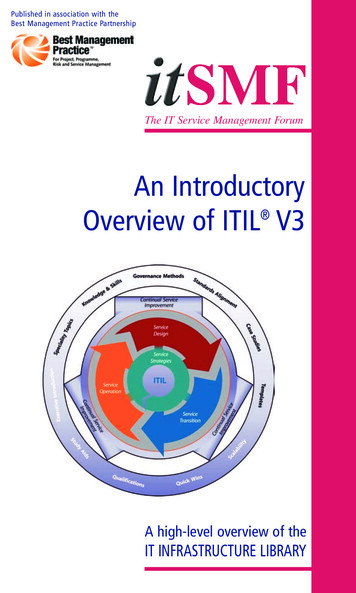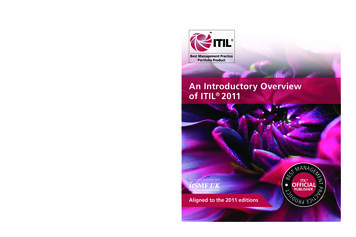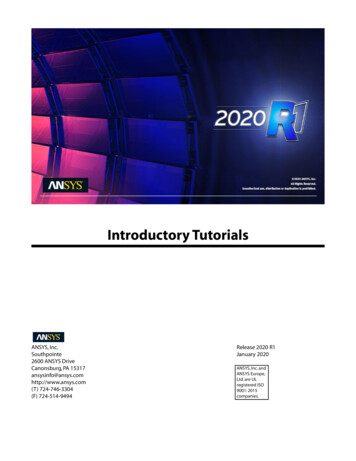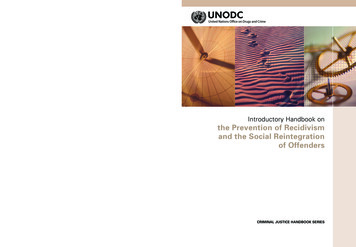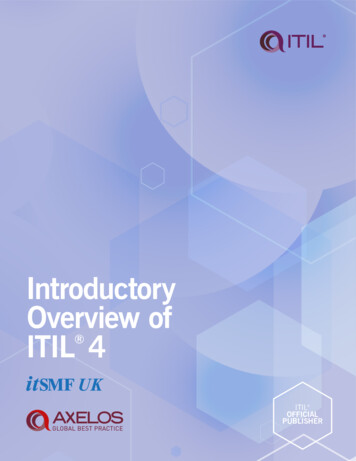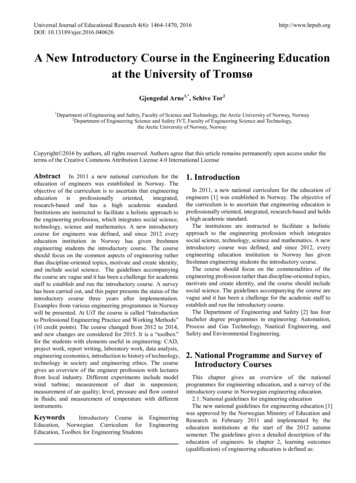
Transcription
Universal Journal of Educational Research 4(6): 1464-1470, 2016DOI: 10.13189/ujer.2016.040626http://www.hrpub.orgA New Introductory Course in the Engineering Educationat the University of TromsøGjengedal Arne1,*, Schive Tor21Department of Engineering and Safety, Faculty of Science and Technology, the Arctic University of Norway, Norway2Department of Engineering Science and Safety IVT, Faculty of Engineering Science and Technology,the Arctic University of Norway, NorwayCopyright 2016 by authors, all rights reserved. Authors agree that this article remains permanently open access under theterms of the Creative Commons Attribution License 4.0 International LicenseAbstract In 2011 a new national curriculum for theeducation of engineers was established in Norway. Theobjective of the curriculum is to ascertain that rated,research-based and has a high academic standard.Institutions are instructed to facilitate a holistic approach tothe engineering profession, which integrates social science,technology, science and mathematics. A new introductorycourse for engineers was defined, and since 2012 everyeducation institution in Norway has given freshmenengineering students the introductory course. The courseshould focus on the common aspects of engineering ratherthan discipline-oriented topics, motivate and create identity,and include social science. The guidelines accompanyingthe course are vague and it has been a challenge for academicstaff to establish and run the introductory course. A surveyhas been carried out, and this paper presents the status of theintroductory course three years after implementation.Examples from various engineering programmes in Norwaywill be presented. At UiT the course is called “Introductionto Professional Engineering Practice and Working Methods”(10 credit points). The course changed from 2012 to 2014,and new changes are considered for 2015. It is a “toolbox”for the students with elements useful in engineering: CAD,project work, report writing, laboratory work, data analysis,engineering economics, introduction to history of technology,technology in society and engineering ethics. The coursegives an overview of the engineer profession with lecturesfrom local industry. Different experiments include modelwind turbine; measurement of dust in suspension;measurement of air quality; level, pressure and flow controlin fluids; and measurement of temperature with differentinstruments.KeywordsIntroductory Course inEducation, Norwegian Curriculum forEducation, Toolbox for Engineering StudentsEngineeringEngineering1. IntroductionIn 2011, a new national curriculum for the education ofengineers [1] was established in Norway. The objective ofthe curriculum is to ascertain that engineering education isprofessionally oriented, integrated, research-based and holdsa high academic standard.The institutions are instructed to facilitate a holisticapproach to the engineering profession which integratessocial science, technology, science and mathematics. A newintroductory course was defined, and since 2012, everyengineering education institution in Norway has givenfreshman engineering students the introductory course.The course should focus on the commonalities of theengineering profession rather than discipline-oriented topics,motivate and create identity, and the course should includesocial science. The guidelines accompanying the course arevague and it has been a challenge for the academic staff toestablish and run the introductory course.The Department of Engineering and Safety [2] has fourbachelor degree programmes in engineering: Automation,Process and Gas Technology, Nautical Engineering, andSafety and Environmental Engineering.2. National Programme and Survey ofIntroductory CoursesThis chapter gives an overview of the nationalprogrammes for engineering education, and a survey of theintroductory course in Norwegian engineering education.2.1. National guidelines for engineering educationThe new national guidelines for engineering education [1]was approved by the Norwegian Ministry of Education andResearch in February 2011 and implemented by theeducation institutions at the start of the 2012 autumnsemester. The guidelines gives a detailed description of theeducation of engineers. In chapter 2, learning outcomes(qualification) of engineering education is defined as:
Universal Journal of Educational Research 4(6): 1464-1470, 2016 Knowledge Skills General competenceThe learning outcome is specified and explained. Theprogramme should ensure equality in learning outcomesbetween the institutions and facilitate mobility. Common toall programmes is that institutions should be able todocument how the national qualifications are obtained inthe study programme, as well as study field and course level.The students will achieve the same learning outcomes. Theinstitution has the freedom to choose the content,organization and assessment used to achieve the results.In chapter 3 [1] general guidelines for the structure andcontents are described using standardized nationalterminology. A study is made up of courses and groups ofcourses. A degree in engineering has four subject categories,where some courses are compulsory, and other topics areelective to define an education profile. A programme ofstudy is a coherent course of study made up of topics andtopic groups. A study may have several specializations.A programme of study consists of programme modules,and the individual courses that will collectively fulfil therequirements for learning outcomes. Curriculum name anddescription must be in accordance with content. Informationand communication technology are integrated and used as atool in education, both technical and pedagogically.Institutions should have close contact with the relevantsectors of engineering during both preparation andimplementation of the programmes.A bachelor's degree in engineering is obtained aftercompletion of the study. The candidate must have passed atleast 180 credits consisting of the following subject groups: 30 credits common topics (mathematics,engineering professional systems thinking, andintroducing methods for engineering profession andwork) 50 credit programme topics (technical subjects,science (physics and chemistry) and social studies) 70 credits technical specialization courses for eachengineering programme, including the bachelorthesis 30 credits elective coursesChapter 4 [1] “Characteristics of new engineeringeducation”, states that quality in engineering education isdescribed by characteristics and associated indicators.Characteristics and indicators will contribute to thecontinuous development of quality. An education of highinternational quality demonstrates these characteristics andperforms well against the indicators. The characteristicsgive institutions the opportunity to compare programmesacross institutions. The characteristics are: Integrated and holistic education In front of professional updating Updated and varied teaching and assessment 1465Research and development orientationProfession competence and practical skillsInternational competenceInterdisciplinary, innovation and entrepreneurshipStudent effort and study masteryEngineering formationThis chapter also gives a detailed description of thecharacteristics. For the introductory course, characteristicVIII emphasize the engineering profession. The group ofcommon topics will contribute to the students study mastery,motivates and raises awareness about the student’s choiceof study, and provides training in study skills. Computingtraining, writing practice, reading instruction andpresentation skills are a focus of the study.Chapter 5 [1] of the national guidelines specifiesindicators for successful application of the characteristics ofVIII. These are: The study environment, teaching and learningmethods, and assessment stimulates to increasedstudent effort and study mastery. The first semester motivates for the engineeringprofession and study programme, and stimulate thestudy environment for the field of engineering, andacross study programmes.Chapter 6 [1] of the national guidelines specifies learningoutcomes for programmes for civil engineering, computerscience, electrical, chemistry and mechanical engineering,and for selected topics like mathematics, sciences and socialstudies. It also gives a detailed description of theintroductory course and a learning outcome description inattachment 4.2.2. Survey of Introductory CoursesThe survey ([3] first presented by T. Schive at a nationalconference) is based on a review of course descriptions andsyllabuses for a variety of introductory courses atNorwegian university colleges and universities. The surveytook place three years after the new curriculum wasimplemented. There are fifteen colleges and universities inNorway that offer engineering programmes at the bachelorlevel. Engineering educational programmes have verydifferent sizes, from Bergen University College, with morethan six hundred engineering students per year, to Sogn ogFjordane University College with approximately thirtyengineering students per year. Table 1 provides an overviewof institutions with engineering programmes, the number ofintroductory courses per institution and number of studentswho graduated in the introductory course in 2013 perinstitution (data from database of higher education, DBH[4]). The table also shows obtained documentation inaddition to course description.
1466A New Introductory Course in the Engineering Education at the University of TromsøTable 1. Introductory courses in Norwegian engineering educations [3]. From 1.1.2016 Buskerud and Vestfold UC and Telemark UC are merged to UCof Southeast Norway, Aalesund UC, Gjøvik UC and Sør-Trøndelag UC are merged and included in Norwegian University of science and Technology(NTNU) and Narvik UC is merged and is a part of UiT.Institutions(UC - University College)Number ofintro. coursesBuskerud and Vestfold UCAalesund UC22Total number ofstudents on intr.courses256150Bergen UC5616Gjøvik UCNarvik UCOslo and Akershus UC245209295411Østfold UCSogn og Fjordane UCSør-Trøndelag UC21617830501Telemark UCStord/Haugesund UCNorwegian University of LifeSciencesUniversity of AgderUniversity of StavangerUiT – The Arctic University ofNorway111171140-151362441101Online course descriptions are reviewed for allintroductory courses, but because the course descriptionscan be very general, it has been necessary to obtaincurricula etc. from fall semester 2014 for some of theintroductory courses. Teaching plans usually provide adetailed overview of the teaching programme on a weeklybasis, with a brief description of the professional content.The documentation is supplemented with phone calls andemail correspondence when there has been a need forclarifications, and such communication has mainly beenwith professionals who teach the introductory course.It is common that the institutions have several variants ofthe introductory course, either in the form of several coursecodes or parallel sessions in a common course. In total,there are about forty varieties of the introductory course inNorway. In some cases, there are practical reasons forhaving more than one introductory courses, e.g. to split theproduction of credits between departments or because theinstitution has several campuses. All study programmeshave defined one course of ten credits as the programme’sintroductory course, but the course name may vary. There isno study that has split up the introductory course, or mergedit with other topics. The introductory course is usually inthe first semester. Colleges in Bergen, Oslo andSør-Trøndelag who have high student numbers, haveseparate introductory courses for each engineeringeducation programme, for example: civil engineering,computer science, electrical, chemical and machineengineering, and these are taught independently. At severaluniversity colleges, the introductory course consists of onecommon part with a general theme, and one study specificDocumentations from 2014Syllabus (Vestfold)Syllabus for automation, computer science andcivil engineeringSyllabus for electro, chemistry, project for civilengineeringLectures onlineSyllabus and project infoSyllabus for chemistry, web resources forElectrical and Electronic EngineeringSyllabus (all engineering programmes)Project info for Chemistry and MaterialsTechnology. Syllabus for Chemistry, ComputerEngineering, Materials Technology, Electrical,Mechanical and Logistics EngineeringSyllabusLectures onlineProject for civil engineeringSyllabuspart. University colleges with few engineering programmesand few students choose to give one introductory course(due to limited resources).A survey of the first version of the course at Gjøvik UC,Østfold UC, Buskerud UC, Vestfold UC and University ofAgder UiA was presented at a conference in 2012 [5]. AtGjøvik UG the students had mandatory courseworkconsisting of 3 individual multiple choice exercises,participation in laboratory experiments and excursions tolocal industry, and writing a report. Assessment was basedon project and individual professional article. The surveywas conducted among the students (Quest back), with somecommon questions and supplementary questions from eachinstitution. Key questions (problem) in the survey were: Lectures and project are not well enough coordinated Many lecturers increasing need for information Many topics makes the course fragmented The course is too early in the study programThe author’s recommendation for the future was: Later start of the project Fewer lecturers and fewer topics Reducing the level of ambition Test covering the whole syllabus Interdisciplinary project groupsAs another example, from autumn 2015 at Aalesund UC,about half of the lectures cover common issues to all theengineering programs, and the other half is especially foreach program [6]. The assessment (passed/failed) is basedon semester paper, project assignment (assessmentportfolio).
Universal Journal of Educational Research 4(6): 1464-1470, 2016UiT had a survey (quest back) autumn 2015, but theresponse among the students was only about 20%, and theresults were on average level. The teachers also had adiscussion about what changes should be made, whetherwritten examinations should be skipped, if the scope andlength of the project period should be increased, if theproject should be assessed (A-F) etc. We agreed not tomake changes in 2016, but wait until 2017 when the coursewill be coordinated with IVT-faculty (former Narvik UC).A publisher consider to write a textbook that covers mostof the curriculum, and if several institutions use the newtextbook (for the general part of the curriculum), the coursewill be more equally among the various institutions.3. Introductory Course at UiTThis chapter presents course description andimplementation at the UiT – The Arctic University ofNorway.3.1. Course DescriptionAt UiT the course is called “Introduction to ProfessionalEngineering Practice and Working Methods” (10 creditpoints). The course description [7] is almost identical to thenational guidelines. The following description is from theautomation programme 2014 (which is identical to the otherprogrammes).Contents: Engineering profession, the engineer's role in society The history of technology Using computers/software CAD (Computer Aided Design) HSE (health, safety and environment) Measurement techniques Data collection methods Project work, project organization, report writing EthicsKnowledge: The candidate has a basic understanding of theengineering profession and the engineer's role insociety and workplace. The candidate has knowledge to see technology inboth historical and forward-looking perspective.Skills: The candidate can identify engineering issues, seekthe necessary information and assure the quality ofthis as a basis for problem solving. The candidate is familiar with basic processes ofinnovation and innovation in connection with projectwork. The candidate is familiar with methods of datacollection. The candidate may use technical drawing as acommunication aid.1467General competence: The candidate is aware of environmental and ethicalconsequences of technological products andsolutions. The candidate is familiar with how he/she can sharetheir knowledge and experiences with others, bothwritten and oral, and can cooperate in a group. The candidate can use modern computer tools intheir engineering.Course form: Lectures, project, laboratory and exercises.Assessment is based on an individual examination withinCAD (40%) and a written examination (60%). To participatein the written examination, the project - as well as any otherrequirements for compulsory work must be approved. Toparticipate in the CAD examination, mandatory work in thissubtopic must be approved. Both parts must be passed toachieve a grade. The grades are A-F.3.2. Syllabus and ImplementationThe syllabus is a detailed description of the weeklycontent, responsible lecturer, working requirements and anindex of literature. The smaller topics (like history oftechnology, ethics, engineering profession, energy theory,intellectual property rights (IPR), report writing and projecttheory) are spread out between the larger parts (computeraided construction; electro technology; measuring technique;data collection and analysis; laboratory and project work andengineering economics). As there are students from everyengineering program and several (experienced) lecturers, itis challenging to plan and accomplish the course.The course is a “toolbox” for the students with elementsuseful in engineering education: CAD, project work, reportwriting, laboratory work, and data analysis. Other topics areplaced in the introductory course because they are too smallfor a course of ten ECTS, and do not match other topics orcourses. Those topics (like engineering economics, ethics,IPR, HSE) are relevant as a professional engineer.The overview of the engineering profession presents abroad selection of engineering work, working conditions inNorway, and job prospects in local industry for UiTengineering programmes. One of our former studentsworking in a local company gives a lecture of his workingexperiences.History of technology gives an overview of national andlocal industry and the (offshore) oil industry. Also theperspective of what you need (of tools and technology) tosurvive in the arctic from the first inhabitants after the lastice age 10 – 12.000 years ago. The importance of marine(fishery) and maritime (development of boats), local naturalresources (minerals and mining, hydroelectric power, fish),cornerstone businesses, industrial clusters, space scienceand earth observation (from satellites), innovations andresearch-based new business are highlighted.In ethics, there are lectures with formal definitions anddiscussion groups on ethical dilemmas.
1468A New Introductory Course in the Engineering Education at the University of Tromsø3.3. Computer Aid Construction (CAD)Computer Aided Construction (or Design as in theacronym CAD) is in the first part of the course wherestudents learn to use Inventor [8]. Software training incomputer-aided design (CAD), where students make3D-models of physical objects and produce engineeringdrawings, is included in the introductory course. Themotivation for including CAD in the course is to provide atool for the core engineering activity: the design anddevelopment of technical devices. Engineering drawings ingeneral are considered relevant for all engineering branches,and the students are introduced to the standardized ways ofcommunicating technical solutions through drafting anddrawings. The CAD-training is mainly taking place in aPC-lab where the students are using the Autodesk Inventorcomputer software. Their skills are developed throughpracticing under supervision. The CAD-training is threefold,they produce their own parts electronically, they l
A New Introductory Course in the Engineering Education at the University of Tromsø . Gjengedal 1Arne ,*, Schive Tor. 2. 1. Department of Engineering and Safety, Faculty of Science and Technology, the Arctic University of Norway, Norway. 2. Department of Engineering Science and Safety IVT, Facult




